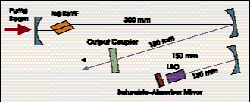
Passive Stabilization Technique Tames Unruly Mode-Locked Laser
Breck Hitz
There is a delicate balance between too much saturable absorption and too little when passively mode-locking a laser. Too little absorption yields unstable mode-locking or, worse, fails to mode- lock the laser at all. Too much causes the laser to Q-switch as well as mode-lock. Now, a collaboration between the Universitá di Pavia and the Universitá di Pisa, both in Italy, has developed a technique to ensure stable, continuous-wave (i.e., non-Q-switched) mode-locking in an Nd:BaY2F8 (Nd:BaYF) laser.
Passively mode-locked lasers often use Nd:LiYF4 (Nd:YLF) as the laser crystal because of that material's wide fluorescence linewidth, which facilitates short-pulse mode-locking. Moreover, Nd:YLF's favorable thermal properties often result in less thermal lensing and diffraction loss than better-known crystals such as Nd:YAG and Nd:YVO4. The scientists in Italy worked with a different neodymium-fluoride laser crystal, Nd:BaYF, which has nearly twice the fluorescence bandwidth of Nd:YLF and could therefore be capable of generating subpicosecond mode-locked pulses.

The intracavity second-harmonic-generation crystal (LBO) compensates for the excessive loss of the saturable-absorber mirror and allows stable, non-Q-switched mode-locking.
Although the scientists have not yet produced pulses in the subnanosecond regime, they have achieved stable CW mode-locking by inserting a nonlinear lithium-borate (LBO) crystal into their resonator (see figure). The Nd:BaYF crystal was a thin slab, 11.4 mm long, with 0.6 percent atomic doping. It was pumped with up to 25 W of 806-nm light from a fiber-coupled diode laser. The pump light was coupled into the resonator through one end mirror, and the other end mirror was a saturable-absorber mode-locker.
As a result, a folding mirror in the middle of the resonator served as the output coupler, and the laser's output consisted of two beams, one corresponding to each direction of the intracavity circulating power. The mode-locker introduced a 2 percent saturable loss, the lowest commercially available at the time of the experiment. The scientists first ran the laser without the nonlinear crystal and observed only Q-switched modelocking, a result they attributed to excessive saturable loss in the mode-locker.
To counter the excessive absorption, they inserted the nonlinear, second-harmonic-generation (SHG) crystal into the resonator. In a saturable absorber, the loss diminishes as greater power impinges on the material because the absorbing transition saturates as the populations of the upper and lower quantum levels approach equilibrium. In an SHG crystal, in contrast, the loss increases as greater power impinges on the crystal because the loss (i.e., the second-harmonic conversion efficiency) is proportional to the incident power. As a result, the SHG crystal acts as a "negative" saturable absorber, directly offsetting the effect of the saturable absorber.
The scientists obtained stable CW mode-locking with the LBO crystal near phase-matching, but the pulses were unduly long -- in excess of 30 ps. A mathematical analysis indicated that not only SHG, but also self-phase modulation in the nonlinear crystal, affects the mode-locked performance of the laser. Accordingly, they operated the nonlinear crystal farther from phase-match, which yielded stable CW mode-locking with pulses shorter than 5 ps. The pulse duration was stable over an output power range of 700 to 960 mW.
The researchers believe that their results are the first successful CW mode-locking of an Nd:BaYF laser. They noted that the availability of saturable absorbers with lower loss than the one they used should permit stable CW mode-locking without a nonlinear crystal.
Published: September 2004